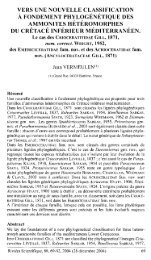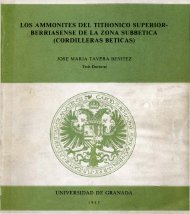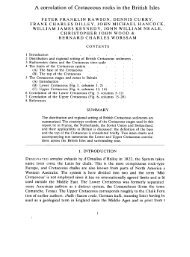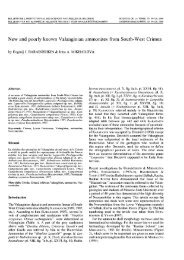— 645 —D ia g n o s is :The radiais have high external surface. The largebasais are visible on <strong>the</strong> calyx surface. The cirrus socketsand fossae are absent. The centrodorsal is smalland conical. The stem facet is small, rounded andflat.T y p e l o c a l it y :Kuibyshevo, Belbek Valley, Crimea.T y p e l e v e l :Upper Berriasian.Co m p a r i s o n :Conoideocrinus differs <strong>from</strong> o<strong>the</strong>r genera <strong>of</strong> <strong>the</strong>family having high-conical calyx with large basais andwith no trace <strong>of</strong> <strong>the</strong> cirrus socket or fossa.One type species.Lower Cretaceous (Berriasian) ; Crimea.D e s c r i p t i o n :The calyx is high-conical, smooth and rounded. Theexternal radial surface is very high. The sutures between<strong>the</strong> radiais, basais and <strong>the</strong> centrodorsal arehardly visible. Radial facets are narrow. The calyxcavity is broad and deep. Radial and interradial furrowsare weak. The height <strong>of</strong> <strong>the</strong> centrodorsal is smallerthan that <strong>of</strong> <strong>the</strong> radial ring. The centrodorsal basisis rounded and flat with a pronounced fulcral ridge.Conoideocrinus conoideus nov. sp.D e r iv a t io n o m i n i s :fig. 10 AThe name <strong>of</strong> <strong>the</strong> species comes <strong>from</strong> « conoideus »(cone-shaped in Latin).D i m e n s i o n s :H t = 7.9 mm ; Dt = 11.0 mm ; Dc = 6.2 mm ; Af= 26° ; Hr : H t = 0.51 - 0.72 ; Bf : Lf = 0.33 - 0.38.M a t e r i a l :One calyx (see table 1).H o l o t y p e :CK-97-1 (fig. 10 A) ; Leningrad Mining Institute.D i s t r i b u t i o n :Berriasian ; Crimea.Fig. 10 — Calyxes and brachials <strong>of</strong> Conoideocrinus and Umbocrinus (x 3).A - C. conoideus, holotype CK-97-1 (calyx <strong>from</strong> side).В - U. umbonatus, CK-89-4 (small calyx <strong>from</strong> side).С - U. umbonatus, CK-83-2 (calyx <strong>from</strong> side).D - U. umbonatus, CK-83-6 (odd secondbrachial <strong>from</strong> above - on <strong>the</strong> left, and <strong>from</strong> below - on <strong>the</strong> right).Е - U. umbonatus, CK-83-7 (even secondbrachial <strong>from</strong> above).Coupes dorsales et brachiales de Conoideocrinus et Umbocrinus.A - C. conoideus, holotype CK-97-1 (coupe dorsale vue de côté).B - U. umbonatus, CK-89-4 (petite coupe dorsale vue de côté).С - U. umbonatus, CK-83-2 (coupe dorsale vue de côté).D - U. umbonatus, CK-83-6 (secundibrachiale impaire vue en dessus - à gauche, vue en dessous - à droite).E - U. umbonatus, CK-83-7 (secundibrachiale paire vue en dessus).
— 646 —T y p e s p e c ie s :Genus Umbocrinus nov. gen.Umbocrinus umbonatus nov. gen., nov. sp.D i a g n o s i s :The radiais have low external surface. The basaisare visible on <strong>the</strong> calyx surface. A row <strong>of</strong> fossae is placedon <strong>the</strong> suture between <strong>the</strong> radiais and <strong>the</strong> centrodorsal.The centrodorsal is small and convex. Thestem facet is rounded and concave.C o m p a r i s o n :Umbocrinus differs <strong>from</strong> Solonaerium and Thiolliericrinuslacking cirrus sockets ; <strong>from</strong> Burdigalocrinusby <strong>lower</strong> radiais and by <strong>the</strong> fossae being placed onlyon <strong>the</strong> radial-centrodorsal suture ; <strong>from</strong> <strong>the</strong> similargenus Heberticrinus by <strong>the</strong> fossae on <strong>the</strong> calyx and <strong>the</strong>basais on <strong>the</strong> external calyx surface.One type species.Lower Cretaceous (Berriasian) ; Crimea.The radial facets are wide. The calyx cavity is broadand shallow. The radial and interradial furrows arepronounced. The basais are visible or invisible on <strong>the</strong>bottom <strong>of</strong> <strong>the</strong> calyx cavity. The primaxillary is flattenedwith strongly convex, smooth or granulated externalsurface. The height <strong>of</strong> <strong>the</strong> centrodorsal roughlyequals that <strong>of</strong> <strong>the</strong> radial ring. One to three deep fossaeare placed under each radial, on <strong>the</strong> radial = centrodorsalsuture. The centrodorsal basis is wide, roundedand concave. The stem facet is narrow-elliptical. Thecolumnals are low, parallel, rarely cruciate or oblique.Their external surface is smooth or granulated.The fulcral ridge is serrated. Intermediate ridges are<strong>of</strong>ten developed on <strong>the</strong> columnal articula.D i m e n s i o n s :Ht = 4.5 - 10.2 mm ; Dt = 7.0 - 21.0 mm ; Dc =5.0 - 10.0 mm ; A f = 45 - 57° ; Hr : H t = 0.09-0,25 ; Bf : Lf = 0.48 - 0.64.M a t e r i a l s :32 calyxes, 21 centrodorsals, 8 brachials, 52 columnals(see table 1).Umbocrinus umbonatus nov. sp.fig. 10 B-E ; pl. 1, fig. 7-11D i s t r i b u t i o n :Berriasian ; Crimea.D e r iv a t io n o m i n i s :Th'ê name <strong>of</strong> <strong>the</strong> species comes <strong>from</strong> « umbonatus »(convex in Latin).H o l o t y p e :CK-89-1 (pl. 1, fig. 7) ; Leningrad Mining Institute.T y p e l o c a l it y :Kuibyshevo, Belbek Valley, Crimea.T y p e l e v e l :Upper Berriasian.D e s c r i p t i o n :The calyx is low, smooth and rounded. The basaisare visible on <strong>the</strong> calyx surface but sometimes not inall interradia. The external radial surface is low, convex,smooth or rarely covered with small granules.T y p e s p e c ie s :Genus Heberticrinus nov. gen.Eugeniacrinus heberti D e L o r i o l in P i c t e t , 1868.D i a g n o s i s :The radiais are with or without low external surface.The basais are invisible on <strong>the</strong> calyx surface.Rarely <strong>the</strong>y look like tiny triangular plates. The centrodorsalis large, convex with no cirrus socket orfossa. The stem facet is concave, flat or rarely convex.C o m p a r i s o n :Heberticrinus differs <strong>from</strong> all genera <strong>of</strong> <strong>the</strong> familylacking cirrus sockets or fossae on <strong>the</strong> centrodorsal. Itdiffers <strong>from</strong> Conoideocrinus, which has no socket orfossa, by <strong>the</strong> large massive centrodorsal, by <strong>the</strong>absence <strong>of</strong> basais on <strong>the</strong> external calyx surface and by<strong>the</strong> low radiais.
















